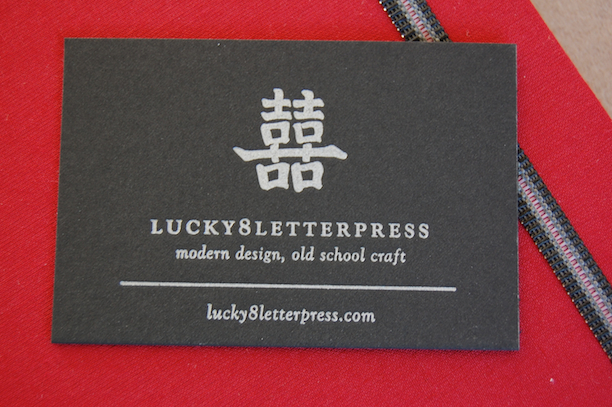A guest post from our new sponsor and long time friend from my college a cappella group (think the Sing-Off), Cindy Lin:
Hi Eagle’s Nest readers!
I’m Cynthia Lin, of LUCKY 8 LETTERPRESS, and I’m jumping in today to guest-post a little Q&A about letterpress printing. I invite you to check out the Lucky8 Etsy shop – use coupon code “EAGLESNEST” and get free US shipping through the end of the year!
Q: How did you get into letterpress?
A: I got into letterpress through another artistic pursuit – I’m also a singer-songwriter. (Fun fact for readers – Jess and I were in an a cappella group together in college!) My first album was professionally manufactured – for my second album, I wanted something more personal, and I loved the idea of using recycled packaging and printing CD cases myself. A friend introduced me to the idea of letterpress, and I found a studio in Brooklyn where I could learn to print and rent a press. It was such a thrill to print my own limited edition CDs.
Other musicians began asking me to print CD cases for them, and then just by word of mouth I was printing invitations, business cards, bookmarks, stationery, custom wedding favor CDs. Now I’m printing non-stop.
Q: What is your process? Do you have your own press now?
A: I recently moved to San Francisco, where the handmade arts are extremely popular, and I found a great studio to rent a letterpress. I print on a Vandercook, which weighs nearly a ton – if I ever move out of the city, I might get my own, but for now, I’m happy to rent and have someone else maintain the press.
So, the reason letterpress printing is so expensive is because there are so many steps and details to the craft. First, you need a design that’s letterpress-friendly: line art and type work best, large solids require more finesse to ink properly. Second, I make a plate of the art, which has the negative (mirror) image and gets placed on the press bed.
Third, I mix ink, add ink to the rollers, adjust roller height and paper alignment, and pull a print to check my initial ink density, print impression, and paper registration. Because each paper has a different thickness, softness, ink absorbent quality, and color, every project requires fine adjustments. This fourth step is where letterpressers drive themselves crazy, in a neurotic, fulfilling way. I might add tiny dots of ink, or clean off a touch of ink, or double ink each print. I may add a bit of tissue-paper packing to get a hair more impression, or feed an extra sheet. It might take 30 proof sheets to get the print quality that I want or I might hit it on the first try. When I’m finally ready to print, I hand-feed each sheet through the press one by one, and keep a close eye on ink consistency and registration. Beyond printing, I spend time experimenting with different papers (including brown recycled chipboard and black cotton museum board).
Q: Where do you get your inspiration?
A: I’m a total nerd for the craft of letterpress printing — my goal is to create designs that will maximize the beauty of ink, impression, and paper. I love white space, bold color, super crisp impression, unique papers, and ultimately I enjoy “petting” the paper and running my fingers over the textured details.
For custom work, it’s important to me to capture the personality of whomever I’m creating for. I love hand-drawings, which I can turn into digital art to print. I am also a big fan of typography – the right font makes all the difference, and I often create custom fonts to perfectly suit each project.
Q: Why do you think these sorts of hand-made arts are making a comeback?
A: First of all, it’s hugely satisfying to make real, physical things. Most people have jobs with no tangible product. When you work with your hands, there’s a rush, an instant gratification, and a sort of soothing magic that comes, and you love whatever you made, no matter the imperfections. Second, the ease of digital reproduction has made us run towards one-of-a-kind goods. It’s an expression of individualism – we want to define our own style and embrace our idiosyncrasies. I love buying hand-made goods because I know I’m directly supporting someone’s artistic expression and encouraging more creativity.
Thanks Cindy! Stay tuned for a post about the beautiful announcement Cindy did for Baby Bryan’s birth.






